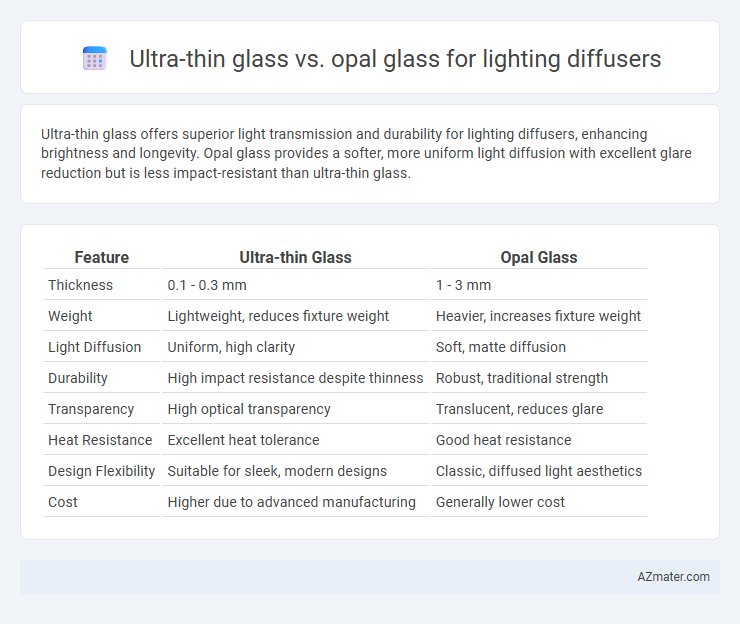Ultra-thin glass offers superior light transmission and durability for lighting diffusers, enhancing brightness and longevity. Opal glass provides a softer, more uniform light diffusion with excellent glare reduction but is less impact-resistant than ultra-thin glass.
Table of Comparison
| Feature | Ultra-thin Glass | Opal Glass |
|---|---|---|
| Thickness | 0.1 - 0.3 mm | 1 - 3 mm |
| Weight | Lightweight, reduces fixture weight | Heavier, increases fixture weight |
| Light Diffusion | Uniform, high clarity | Soft, matte diffusion |
| Durability | High impact resistance despite thinness | Robust, traditional strength |
| Transparency | High optical transparency | Translucent, reduces glare |
| Heat Resistance | Excellent heat tolerance | Good heat resistance |
| Design Flexibility | Suitable for sleek, modern designs | Classic, diffused light aesthetics |
| Cost | Higher due to advanced manufacturing | Generally lower cost |
Introduction: The Role of Glass in Lighting Diffusers
Ultra-thin glass offers superior light transmission and durability for lighting diffusers, enhancing brightness while maintaining a sleek profile. Opal glass provides excellent diffusion with a soft, uniform glow, effectively reducing glare and hotspots in illuminated environments. Both materials optimize light quality but differ in transparency and aesthetic impact, influencing diffuser performance and design choices.
Key Properties of Ultra-thin Glass
Ultra-thin glass for lighting diffusers offers exceptional clarity, high light transmission rates above 90%, and superior chemical resistance compared to opal glass, which provides diffused light with a softer appearance. Weighing significantly less due to its minimal thickness, ultra-thin glass enhances energy efficiency and reduces product bulkiness. Its highly durable nature allows better thermal stability and scratch resistance, making it ideal for modern, high-performance LED lighting applications.
Opal Glass: Features and Characteristics
Opal glass offers superior light diffusion with its milky-white, semi-opaque surface that evenly scatters light, reducing glare and hotspots. Its robust thermal resistance and durability make it ideal for lighting applications where consistent, soft illumination is desired. Compared to ultra-thin glass, opal glass provides better opacity and diffusion quality, enhancing aesthetic appeal and visual comfort in residential and commercial lighting fixtures.
Light Transmission and Diffusion Comparison
Ultra-thin glass offers superior light transmission rates, typically exceeding 90%, providing brighter illumination with minimal loss of intensity. Opal glass excels in light diffusion, scattering light evenly to eliminate glare and hotspots, making it ideal for softer, more uniform lighting. While ultra-thin glass favors clarity and brightness, opal glass prioritizes diffused, comfortable light, influencing the choice based on specific lighting design needs.
Durability and Strength: Ultra-thin vs Opal Glass
Ultra-thin glass offers exceptional strength-to-weight ratio with high resistance to breakage due to its advanced manufacturing processes, making it highly durable for lighting diffusers. Opal glass provides moderate durability but is generally thicker and heavier, which can lead to increased fragility under impact compared to ultra-thin glass. The enhanced toughness and flexibility of ultra-thin glass make it a superior choice for long-lasting and resilient lighting diffusers in both residential and commercial applications.
Design Flexibility and Aesthetics
Ultra-thin glass offers superior design flexibility with its exceptional thinness, allowing for sleek, minimalist lighting fixtures that enhance modern aesthetics. Opal glass provides a softer, diffused light quality with a classic matte finish, ideal for achieving uniform illumination and timeless elegance. The choice between ultra-thin and opal glass diffusers impacts both the visual appeal and customization range of lighting designs, balancing contemporary sharpness against traditional warmth.
Energy Efficiency and Performance
Ultra-thin glass offers superior light transmission and durability compared to opal glass, enhancing energy efficiency by allowing more natural light to pass through while reducing the need for high wattage bulbs. Opal glass diffusers provide softer, more uniform light diffusion, which can improve visual comfort but may slightly decrease luminous efficacy due to light absorption and scattering. Choosing ultra-thin glass optimizes performance for applications requiring maximum brightness and energy savings, whereas opal glass suits environments prioritizing glare reduction and aesthetic diffusion.
Cost Considerations and Availability
Ultra-thin glass offers a higher upfront cost compared to opal glass due to advanced manufacturing processes and material precision, but it provides enhanced durability and clarity, potentially reducing long-term replacement expenses. Opal glass remains more cost-effective with widespread availability, making it a preferred choice for budget-conscious lighting projects requiring diffuse light distribution. Both materials' pricing and supply can vary by region and supplier, influencing project feasibility and sourcing timelines.
Environmental Impact and Sustainability
Ultra-thin glass offers superior recyclability and lower carbon footprint compared to Opal glass, which often contains additives that hinder recycling processes and increase environmental impact. The production of ultra-thin glass requires less raw material usage and energy consumption, making it a more sustainable option for lighting diffusers. Opal glass's opacity results from added chemicals, raising concerns about toxicity and limiting its environmental sustainability in contrast to cleaner ultra-thin glass alternatives.
Choosing the Right Glass for Your Lighting Diffuser
Ultra-thin glass offers superior light transmission and durability with a sleek, modern appearance, making it ideal for high-end lighting diffusers requiring clarity and strength. Opal glass provides excellent diffusion by softening light and reducing glare, resulting in a warm, even illumination suitable for ambient lighting applications. Choosing between ultra-thin and opal glass depends on the desired balance of light clarity, diffusion quality, and design aesthetics for your lighting project.

Infographic: Ultra-thin glass vs Opal glass for Lighting diffuser
 azmater.com
azmater.com